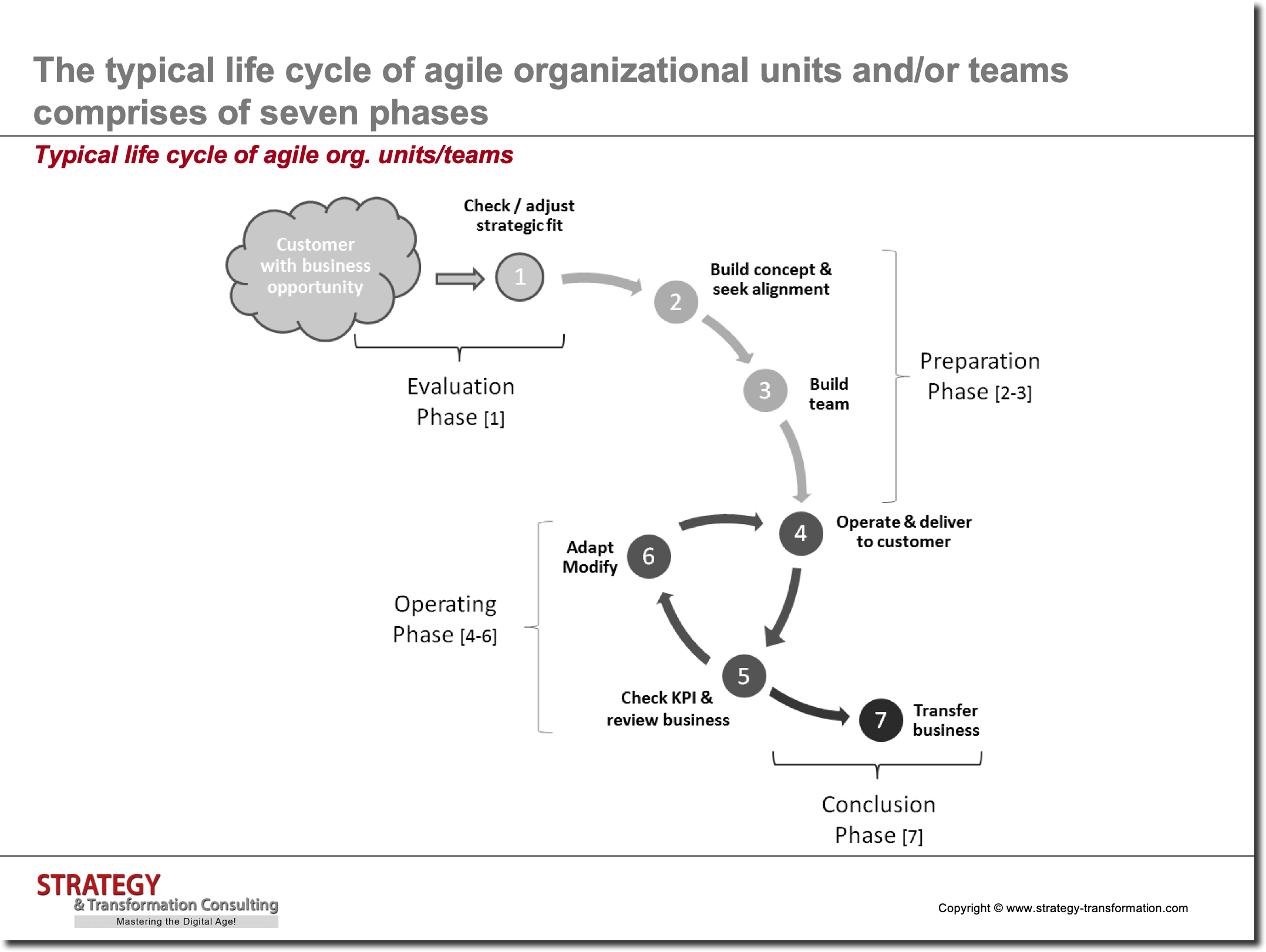Building an Agile “Hybrid” Organization

Being ready and prepared for the digital transformation means a major challenge and effort for many companies, as it implies fundamental changes to almost all aspects of a traditional organization.
Before we discuss a few basic concepts for an agile organization, let’s shortly recap why the topic of “agility” is being discussed so excessively these days. Agility within an organization is not a fundamentally new topic. Software engineering has ever since used agile working methods, tools, and organizational concepts in their development work. Many e-ventures (startups) of the net economy have made agility one of their key working principles right from the beginning. So what is changing now?
Why agile now?
The digital evolution will lead to significant changes in technology, industry and society. It is likely that it will revolutionize most of today’s well established traditional businesses. And of course, it’s not only the super-prominent e-business champions like Uber, Airbnb, or Amazon that have broken into large sectors of the industry, such as the mobility, hotel or retail branches. The risk is coming from the other end as well: small, agile companies conquering step-by-step conventional business areas by innovative, sometimes disruptive e-business approaches. Just one example: for almost all the offerings that you would expect in a classical product portfolio of a bank there are web equivalents already out there: small e-business companies using the web to offer better or more convenient (i.e. mobile) services at lower cost with a higher level of customer centricity. Will we still see bank offices with real tellers a few years from now? To what extent will these web-based e-business service providers really alter the whole banking sector in the long run? Well, I guess, nobody knows for sure. But that’s exactly why the sense of urgency should be here NOW!
Especially traditional companies need to put all of their efforts in preparing for the digital future, its threats as well as its opportunities. It all begins with a continuous monitoring of the trends and developments; it requires a sufficient buildup of digital knowledge and competencies inside and the creation of a flexible e-business strategy that puts the customer in the center of attention. But above all, it demands an executive management mindset of openness, trust and eagerness to truly going new ways instead of just further optimizing the well-known.
Going truly new ways means taking a look at the big picture. It’s not only about using the latest technology or having a cool app out there or improving some individual collaboration processes by using an Enterprise Social Network tool. It’s about the whole setup: technology, processes, organization and the human being. Let’s be clear: of course we need to be as productive and efficient as possible.
Yes, we do indeed need to make use of the latest technological developments such as the internet of things (IoT), the semantic web (web 3.0), artificial intelligence and other technologies. But let’s not forget about the soft factors, the cultural aspects and the resulting consequences for tomorrow’s organizations. That’s what this article is about.

Why is it difficult to make an existing company agile?
To alter an existing, conventional company that is based on the fundamental tayloristic principle of division of labor and run by a hierarchical line organization into an agile, fully connected company based on network structures is much more difficult than launching a new startup or independent subsidiary of this type on the green field. Because after all you need to do both:
- Protect the so-far successful structures that are tuned for maximum efficiency in the existing business, yet carefully adjust them step-by-step in a continuous improvement style
- Re-consider courageously and consistently the entire organizational setup where innovative digital business and/or a VUCA* environment requires more agility, flexibility and effectivity and exceeds the current organizational capabilities (*volatile, uncertain, complex, ambiguous).
A lot of good literature exists on this subject. Some of the more well-known ones are probably John P. Kotter’s concept of the “dual operating systems” that was published in the Harvard Business Review in 2012 and Dave Gray’s book “The Connected Company” which was released in the same year. Still, with theory being well understood, its implementation remains a different – by far more demanding – story.
Ultimately, you will need to re-design your overall organizational framework. This affects the entire set of rules, regulations, agreements, structure, etc. that define how a firm operates. One of the concepts that I will briefly introduce below is called the Hybrid Organization. A “hybrid” organization in this context is an organization that combines elements from both models: the process-centered, highly standardized and efficient line organization as well as the customer- centered, highly connected and effective agile organization.
Hybrid organizations
The hybrid organization comprises four major organizational elements:
- Core structure or backbone – it secures the overall strategy, governance and synergies across the corporation
- Functional units – they assure the operational excellence, protection and further development of the company’s key capabilities, skills, and competencies
- Agile units – they operate closely to/with the customer and the market. They execute the operational business, especially in volatile environments.
- Shared services – they represent the interface between the agile (3.) and the functional (2.) units
The concept is based on the idea of maximum customer centricity and market proximity. Theoretically you could build an entire company just around your customers. Start-ups often begin this way. But of course this does not work in the long run. As the company grows, it would soon drive transactional costs through the roof, when comparable processes were done separately and individually for each customer without gaining any internal economies of scale. With this apparently making no sense, two simple, fundamental questions arise:
- How much can you align your organization’s setup with individual customer and market requirements without losing the internal synergies that save money and effort and make you competitive in the end?
- Where is the optimal balance between effectivity and efficiency, the break-even between flexibility and standardization?
It is a good exercise to approach these questions from the outside perspective by considering the setup and role of agile units. Begin looking at such teams in business sectors that are ideally new (not core of your existing business), little known, volatile and where a lot of creativity and agility is needed:
Agile Units
Agile units are per definition small. They have an interdisciplinary, sometimes cross-hierarchical setup and – most importantly – a common customer objective. They are the “front-end” to the customer and may be empowered to be holistically responsible for a certain desired business objective. They may even become micro companies that organize themselves and actually run an entire chunk of the business with full P&L accountability within a larger organizational framework.
Depending on the type of business, agile teams may only exist temporarily until the specific customer objective is met (see above). Alternatively, multiple agile units may be scaled up to build a permanent agile cluster consisting of numerous agile units and running a certain business (process) permanently. However, since agile units are small and have only a limited number of members, some key aspects need to be considered prior to setting them up:
- What are the specific requirements of the new business and the targeted customers?
- What kind of skillset and capabilities do the agile units need?
- What is the minimum number of team members to reach a critical mass?
- What kind of empowerment, freedom, and accountability does the team need?
- What kind of tools, methodologies, work processes, and working environment?
- What is the strategic framework for the unit’s operations and by which KPI do you measure its progress?
- What support do these agile units need from the rest of the organization?
- Which internal (or external!) groups could act as service providers (suppliers) for the agile unit (client)?

(Shared) Services (ShS)
ShS are the fundamental supporting counterpart of the agile units. Key questions here are:
- what are capabilities and functions that do not directly relate to the customer objective, but are nevertheless needed to make the agile units operationally successful?
- How do the shared services operate when they have multiple agile units as “clients”?
- How can they seek the appropriate internal synergies while at the same time act as service providers to their clients?
- How is their performance evaluated?
- And, which of their capabilities are so strategic to the company that they need to remain inside (see CoC)?
- Which services could be booked from external service providers instead?
Functional Units – Centers of Competency (CoC)
Ideally, functional units which do not operate as Shared Services (see above) represent centers of competencies (CoC). This means that they focus on functional expertise in a certain, strategic key capability area of the company. They are in charge of keeping and further developing the competitive knowledge of the company and applying this knowledge to the business. Typical functional units include research, sales and marketing, engineering, manufacturing and others. Agile units recruit their experts and core staff from these functional units. When the customer objective is met and the agile unit dissolves (step 7), team budget and staff are returned to the functional units.
Today, most operational business in conventional organizations is still run by the line organization. In this context it is irrelevant whether we talk about a functional, matrix-type or process-oriented organization. All of them are characterized by a firm structure and an efficient execution of defined standard business processes which makes perfect sense as long as the business is mature, well-known and stable. In agile organizations however they gain another role: they become internal providers of expertise and staff to their clients, the agile units.
Backbone – the governing core structure
The more de-central and customer-centric an organization is the more important becomes the strategic and organizational framework. Uncoupling units by giving them more individual power, flexibility and independence easily leads to effects of dissolution and lost synergies, or – if you will – new silos. With the connected company targeting exactly the opposite – enhancing synergies and aligning power – it becomes crucial that an agile, connected company operates on a common ground of vision, mission, strategy and resulting values, standards and regulations.
Governance per-se becomes even more important than before. However, the content of governing must be adjusted to the requirements of both the standard and the new, agile businesses. This change process is one of the most difficult ones as it directly reflects the balancing act between synergy and customer centricity, between standardization and individual entrepreneurship. The backbone which includes the top management of a company as well as all governance units is responsible for developing, applying and enforcing the governing core structure. Typical areas belonging to the backbone include: the corporate strategy, legal, HR, finance, organizational development, business process management, PR, and other corporate functions.
All of the above assumes that you start from the well-known structures of a typical organization. You basically re-assign roles, responsibilities and interfaces between existing elements of the organizational structure. Although this might already mean a huge organizational development effort, it may still not be radical enough. Why? Because you do not touch the basic assignment of tasks to functions!
Organizational capabilities
A more fundamental approach would be to start with theorganizational capabilities. Every business (model) requires certain capabilities from the organization. Very often, these capabilities are the result of a more or less efficient cooperation between different parts of the organization and the combination of sub-capabilities that are located there.
Example: the successful acquisition of a project typically requires technical, commercial, strategic, communication and relationship capabilities. To win such a project takes a team of highly capable people from different parts of the functional organization, excellent execution processes, perfect tools, etc.
In order to make these people collaborate and share the same target, you can of course build a temporary team structure: the acquisition team. In addition you will have to make sure that the rest of the organization supports this team, that budget is available, etc.
A more radical approach would be to add a permanent network-type layer across the organization being in charge of the organizational capability “acquiring projects” (which goes beyond acquiring a single project). Anything that is needed to apply and foster this capability would follow: processes, IT, tools, standards, personnel, etc. The same idea could be applied to project management, engineering, and other core processes.
Although the concept of business capabilities as high-level structuring criteria is similar to that of a process-oriented organization, it begins one layer “above” the processes and includes significantly more aspects, i.e. cultural and leadership topics. It offers more flexibility and is thus better adaptable for volatile businesses. Creating a capability map for certain new business (models) with complementing lower-level process maps and feature maps might be a good start for an organizational redesign.
Apparently, such a fundamental change will not happen overnight. Since it will affect most parts of a company, the discussion should start at the very top involving all key stakeholders, but driven actively by the CEO. Once the fundamental concepts are agreed, they can then be applied to a few selected, yet representative areas of the organization to learn rapidly and to gain experiences for a broader subsequent rollout.
It is essential to open up the organizational and regulatory framework in this phase as much as possible – of course within legal and compliance boundaries – to be really open for the new. Even if it may at first sound impossible or unrealistic, chances are high that otherwise you may end-up again with merely doing more of the same instead of truly re-inventing the organization.
We are all aware of how easily we tend to get used to convenient, well-known and successful patterns. The risk is that our own experience becomes our only truth then, preventing us from really finding the best solution outside the box, especially when there is no immediate need for a change. In light of the challenges of the digital evolution we should watch out that this convenience does not become a pitfall later.
Weiterführende Links
Fachkompetenz strukturelle Ausrichtung
About us
Our positioning and mission statement: “Mastering the Digital Age!” We are an integrated management and technology consulting group and offer the conception and implementation of holistic digitization solutions in an integrated manner. In combination, you will receive strategic advice from us on the digitization of your company from real thought leaders with profound methodological knowledge, extensive transformation experience from successful IT system integrators with many years of industry experience and a high level of technological understanding, as well as deep expertise in generating value from data – the new gold of the 21st century – with the help of the latest artificial intelligence (AI) and cloud computing technologies. All this End2End from a single source for the entire transformation process! Find out more about us here.
Ihre Ansprechpartner
Haben wir Ihr Interesse geweckt? Dann schreiben Sie uns oder rufen Sie uns an. Sehr gerne stellen wir Ihnen unsere Beratungsprodukte sowie Fach- und Branchenkompetenzen in einem persönlichen Gespräch detailliert vor. Wir freuen uns darauf, Sie kennenzulernen!

Rüdiger Schönbohm
Partner
Strategy & Transformation Consulting
Email senden

Kommentare geschlossen